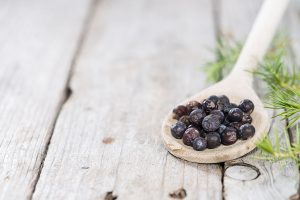
Legislative Background:
Regulation (EC) No 110/20081 on the definition, description, presentation, labelling and the protection of geographical indications of spirit drinks defines Gin as follows:
- Gin is a juniper-flavored spirit drink produced by flavoring neutral ethyl alcohol with juniper berries.
- Flavoring substances shall be used for the production of Gin so that the taste is predominantly that of juniper.
- Distilled Gin is a juniper-flavored spirit drink produced exclusively by redistilling ethyl alcohol in stills traditionally used for gin, in the presence of juniper berries and of other natural botanicals provided that the juniper taste is predominant.
- Gin obtained simply by adding essences or flavorings to ethyl alcohol of agricultural origin is not distilled gin.
- The minimum alcoholic strength by volume of gin shall be 37, 5 %Vol.
In summary, the regulation points out that, while the juniper taste must be predominant, other botanicals can also be added to create a lot of different flavor directions.
Other spirits categories have a much more limited choice for raw materials. That is why Gin is a spirit drink of choice for creators of innovative smell and taste sensations.
New gin generation: botanicals
The use of botanicals opens this spirit category to a wide field of ingredients in addition to juniper berries. Classic choices are:
- coriander
- angelic root
- orange
- lemon peel
The new generation of gin distillers use infusions of exotic botanicals to distinguish their products from traditional Gin. These infusions include:
- hops
- hay flowers
- fennel
- lavender
- aromatic pepper
- grapefruit
- coconut
- geranium
New Gin generation in Germany
The Table below gives an overview about the most famous new Gin brands in Germany and botanicals used.
| Brand Name | Special Botanicals |
| Bavaria Dry Gin2 | angelica root, hop flowers, coriander, ginger, lavender |
| Bavaria Gin3 | hops, fennel seeds, hay blossoms |
| Boar Gin4 | truffle, botanicals |
| The Duke5 | lavender, ginger root, hop blossom, malt |
| Feel Munich Dry Gin6 | blueberries, aroniaberries, lavender; organic, vegan ingredients |
| Krater Noster7 | rhubarb root, pears |
| Monkey 478 | spice sprouts, robinia blossoms, rosehip peels, cube pepper, coriander, paradise grains, muscat, allspice, cardamom, cloves, muscat, almond, ginger, cassia bark, ceylon cinnamon, licorice, calamus root, lavender, violet, rose, hedgehog, bramble rose, blackberry blossom, lemon balm, seed of the angelica, Lemon Bowl, chamomile, sage, black currant, whitethorn and cranberry, flowers of wild honeysuckle9 |
Examples of new Gin brands in Germany
All of these crafted products put a strong claim on regional roots/origin. Manufacturers use traditional copper stills for their distillation.
Next to juniper, botanicals play a central role in the sensory profile of the products. Some of them use even organic raw materials.
All of the products are in the upper price segment and most of them have an alcohol content of 40%Vol or more.
To prepare the famous and popular Gin Tonic cocktail based on these special Gins, many recommend special Tonic water,10 like Fever Tree, Thomas Henry, Aqua Monaco and others.
Although experts have predicted a declining market for the new Gin generation in Germany, sales are still increasing and new creations will enter the market in 2017.
The great flavors spectacular of Gin continues!
References:
- Regulation (EC) No 110/2008 [PDF] on the definition, description, presentation, labelling and the protection of geographical indications of spirit drinks
- Bavaria Dry Gin
- Bavaria Gin
- Boar Gin
- The Duke
- Feel Munich Dry Gin
- Krater Noster
- Monkey 47 homepage
- Monkey 47 Wikipedia page
- http://ginspiration.de/tonic-water/
The views, opinions and technical analyses presented here are those of the author or advertiser, and are not necessarily those of ULProspector.com or UL Solutions. The appearance of this content in the UL Prospector Knowledge Center does not constitute an endorsement by UL Solutions or its affiliates.
All content is subject to copyright and may not be reproduced without prior authorization from UL Solutions or the content author.
The content has been made available for informational and educational purposes only. While the editors of this site may verify the accuracy of its content from time to time, we assume no responsibility for errors made by the author, editorial staff or any other contributor.
UL Solutions does not make any representations or warranties with respect to the accuracy, applicability, fitness or completeness of the content. UL Solutions does not warrant the performance, effectiveness or applicability of sites listed or linked to in any content.



Leave a Reply or Comment